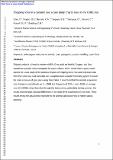Files in this item
Shipping noise in a dynamic sea : a case study of grey seals in the Celtic Sea
Item metadata
| dc.contributor.author | Chen, F. | |
| dc.contributor.author | Shapiro, G. I. | |
| dc.contributor.author | Bennett, K. A. | |
| dc.contributor.author | Ingram, S. N. | |
| dc.contributor.author | Thompson, D. | |
| dc.contributor.author | Vincent, C. | |
| dc.contributor.author | Russell, D. J. F. | |
| dc.contributor.author | Embling, C. B. | |
| dc.date.accessioned | 2017-09-24T23:32:24Z | |
| dc.date.available | 2017-09-24T23:32:24Z | |
| dc.date.issued | 2017-01-15 | |
| dc.identifier | 246164786 | |
| dc.identifier | 45c38f35-0d4a-4085-a337-755caa32ca22 | |
| dc.identifier | 84996536689 | |
| dc.identifier | 000392768900052 | |
| dc.identifier.citation | Chen , F , Shapiro , G I , Bennett , K A , Ingram , S N , Thompson , D , Vincent , C , Russell , D J F & Embling , C B 2017 , ' Shipping noise in a dynamic sea : a case study of grey seals in the Celtic Sea ' , Marine Pollution Bulletin , vol. 114 , no. 1 , pp. 372-383 . https://doi.org/10.1016/j.marpolbul.2016.09.054 | en |
| dc.identifier.issn | 0025-326X | |
| dc.identifier.other | RIS: urn:7A306F3ACA1B1069138A8C2795DB62F2 | |
| dc.identifier.other | ORCID: /0000-0002-1969-102X/work/49052036 | |
| dc.identifier.other | ORCID: /0000-0003-1546-2876/work/56862176 | |
| dc.identifier.uri | https://hdl.handle.net/10023/11731 | |
| dc.description | This study was supported by the EU (via PERSEUS grant FP7-OCEAN-2011-287600 and MyOcean SPA.2011.1.5-01 grant 283367). In addition, C.B. Embling was supported by the 2014 SoMSE Plymouth University Small (grant number 2014-SoMSE) research grant. D.J.F. Russell and D. Thompson were supported by the National Capability funding from the Natural Environment Research Council to the Sea Mammal Research Unit (grant no. SMRU1001). C. Vincent was supported by the Parc naturel marin d'Iroise and Région Poitou – Charentes (grant number 782423). | en |
| dc.description.abstract | Shipping noise is a threat to marine wildlife. Grey seals are benthic foragers, and thus experience acoustic noise throughout the water column, which makes them a good model species for a case study of the potential impacts of shipping noise. We used ship track data from the Celtic Sea, seal track data and a coupled ocean-acoustic modelling system to assess the noise exposure of grey seals along their tracks. It was found that the animals experience step changes in sound levels up to ~ 20 dB at a frequency of 125 Hz, and ~ 10 dB on average over 10–1000 Hz when they dive through the thermocline, particularly during summer. Our results showed large seasonal differences in the noise level experienced by the seals. These results reveal the actual noise exposure by the animals and could help in marine spatial planning. | |
| dc.format.extent | 2734057 | |
| dc.language.iso | eng | |
| dc.relation.ispartof | Marine Pollution Bulletin | en |
| dc.subject | Anthropogenic noise | en |
| dc.subject | Marine animals | en |
| dc.subject | Sound propagation | en |
| dc.subject | Acoustic modelling | en |
| dc.subject | Ocean fronts | en |
| dc.subject | QH301 Biology | en |
| dc.subject | NDAS | en |
| dc.subject | NERC | en |
| dc.subject | SDG 14 - Life Below Water | en |
| dc.subject.lcc | QH301 | en |
| dc.title | Shipping noise in a dynamic sea : a case study of grey seals in the Celtic Sea | en |
| dc.type | Journal article | en |
| dc.contributor.sponsor | NERC | en |
| dc.contributor.institution | University of St Andrews. School of Biology | en |
| dc.contributor.institution | University of St Andrews. Sea Mammal Research Unit | en |
| dc.contributor.institution | University of St Andrews. Marine Alliance for Science & Technology Scotland | en |
| dc.contributor.institution | University of St Andrews. Scottish Oceans Institute | en |
| dc.contributor.institution | University of St Andrews. Centre for Research into Ecological & Environmental Modelling | en |
| dc.identifier.doi | 10.1016/j.marpolbul.2016.09.054 | |
| dc.description.status | Peer reviewed | en |
| dc.date.embargoedUntil | 2017-09-24 | |
| dc.identifier.grantnumber | Agreement R8-H12-86 | en |
This item appears in the following Collection(s)
Items in the St Andrews Research Repository are protected by copyright, with all rights reserved, unless otherwise indicated.

